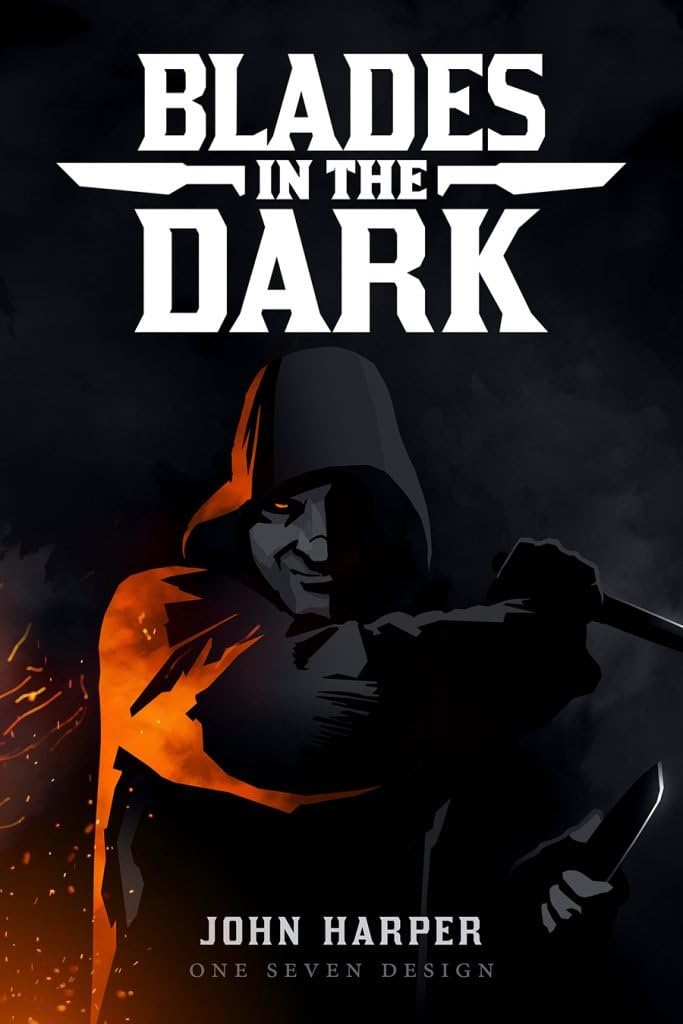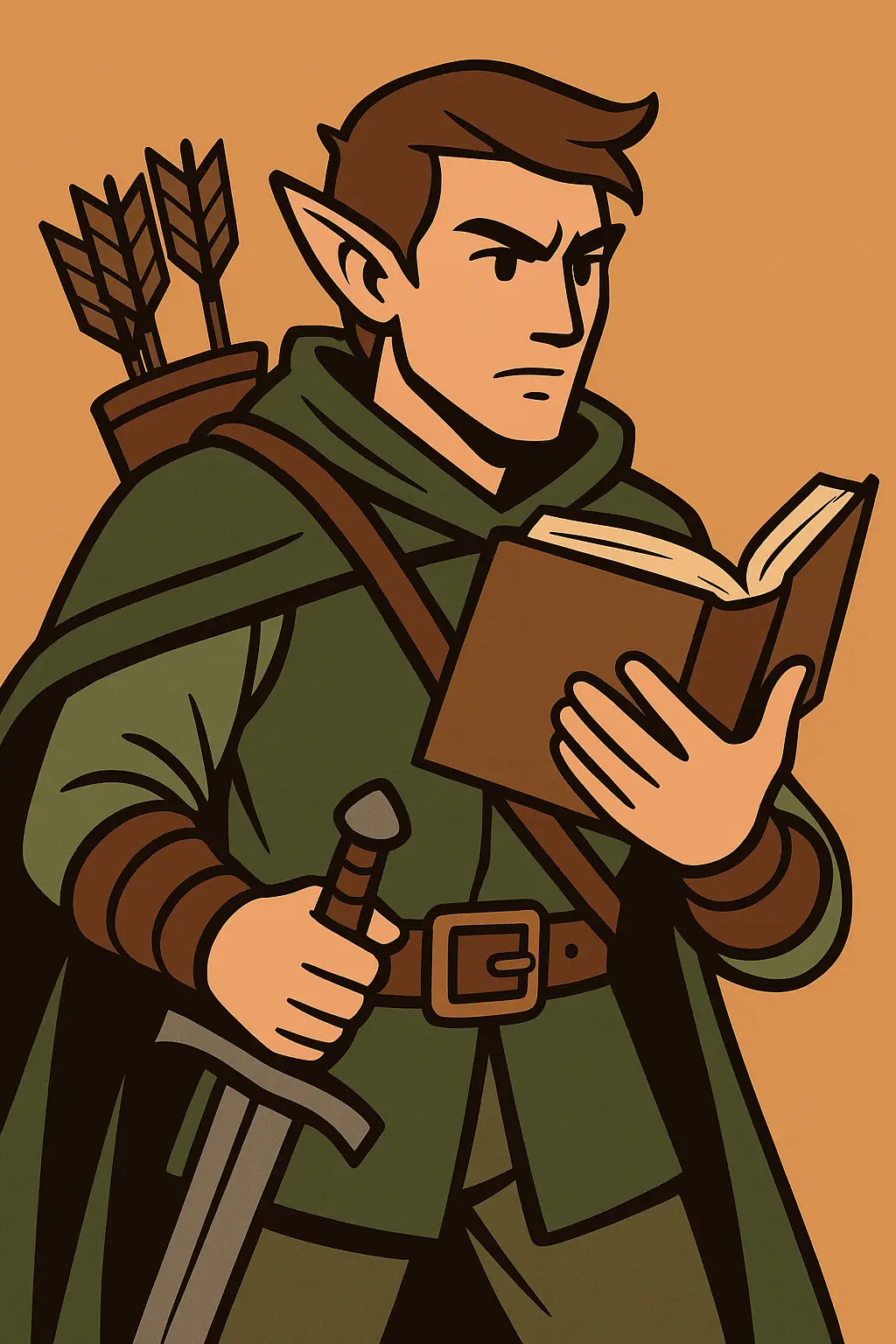A full deep dive into the world of scoundrels, ghosts, and neon-noir criminal empires
Some roleplaying games ask you to save the world.
Blades in the Dark asks you to rob it.
This isn’t your average fantasy game. There are no heroes here. No dungeons to clear or dragons to slay. There are only gangs, scores, and shadows—and you, caught somewhere in between survival and ambition.
Published by Evil Hat Productions, Blades in the Dark is a game that changed how we think about TTRPG pacing, narrative ownership, and the dynamics of risk and reward.
Whether you’re a veteran GM, a player burned out on dungeon crawls, or a storyteller looking to run a criminal drama with bite, this game is your next obsession.
Let’s dive deep into the mechanics, the world, and what makes Blades in the Dark not just a game—but an experience.

🌒 The Premise: Welcome to Doskvol
Imagine a city that never sees sunlight.
Doskvol is a cold, haunted industrial sprawl—half Victorian London, half gothic noir, with a splash of arcane punk for flavor.
The gates of death are broken.
Ghosts roam the alleys.
The rich sip ectoplasm in their skybound towers while the streets seethe with poverty, corruption, and ambition.
Your crew? You’re scoundrels—thieves, smugglers, assassins, cultists.
You’re building a criminal empire, one score at a time.
You’ll deal with:
- Rival gangs
- Corrupt bluecoats (the city’s “police”)
- Demon-blooded nobles
- And worst of all—your own past
If that sounds like the plot of your favorite gritty prestige TV show, you’re exactly right.
🎲 Core Gameplay: Action, Consequence, and Control
Blades in the Dark isn’t about winning fights—it’s about navigating consequences.
The rules are built around three core pillars:
1. Fiction First
Narrative drives the rules—not the other way around. You don’t ask what ability to roll; you describe what you’re doing, and the GM responds with position, effect, and risk.
2. Action Rolls, Not Skill Checks
There are 12 “action” ratings (like Hunt, Skirmish, Prowl, Sway, etc.).
To do something risky, you:
- Roll a number of d6s based on your action rating
- Take the highest die
- The result determines success, complication, or failure
Simple. Elegant. Dangerous.
3. Position and Effect Matter
Every action has a position:
- Controlled (low risk)
- Risky (standard tension)
- Desperate (high reward, high risk)
…and an effect level:
- Limited
- Standard
- Great
This sliding scale makes the difference between:
“You sneak past the guard with ease,”
and
“You get past him, but he heard something. You’ve got company next round.”
It’s dynamic storytelling through dice.
⏱ Time-Saving Innovations
One of Blades in the Dark’s greatest strengths is its streamlined pacing.
Here’s how it avoids the traditional RPG slowdown:
🧠 Flashbacks
Instead of prepping for an hour, players can retroactively spend stress to declare that they already handled something.
“Oh, we bribed that dock official yesterday. Flashback scene. I roll Sway.”
It keeps heists tight and story-driven, without handwaving logic.
🎯 Engagement Rolls
You don’t plan out every detail of a job. You say what kind of job it is, then roll to see how things start.
Success? You’re in clean.
Failure? You’re already on the run. Go!
This puts players in the action immediately, every time.
⌛ Downtime Phase
Between jobs, there’s structured downtime:
- Healing
- Reducing heat (wanted level)
- Working on personal projects
- Indulging vices (to recover stress)
This loop creates episodic rhythm that feels cinematic and complete, every session.
⚔️ Your Crew Is a Character Too
In most RPGs, the party is just a group.
In Blades in the Dark, the crew is a character with its own:
- Abilities
- Upgrades
- Reputation
- Turf
- Special moves
You can be:
- Assassins (high-tier murder-for-hire)
- Smugglers (moving contraband, supernatural or otherwise)
- Cultists (serving forgotten gods)
- Bravos (street enforcers)
- Shadows (classic thieves)
The crew gains XP and reputation alongside the players.
As the crew rises, so do the stakes: rivals come for your turf, allies demand favors, and the city’s factions take notice.
You’re not just playing characters. You’re building a legacy—or an empire destined to fall.
🧬 The Mechanics of Stress, Trauma, and Scars
Characters in Blades don’t have hit points.
They have stress, and when things go wrong, they pay for it emotionally.
🌪 Stress
Used to:
- Resist consequences
- Perform flashbacks
- Push yourself for bonus effect
Stress adds up—when it fills, you take trauma.
💀 Trauma
Not just wounds—these are permanent personality shifts.
Examples:
- Cold
- Reckless
- Haunted
- Soft
- Paranoid
Gain enough trauma, and your character retires—in disgrace, triumph, or worse.
“Characters in Blades don’t die randomly—they spiral, burn out, or walk away.”
It’s gritty. It’s human. And it’s incredibly compelling.
🧱 Progress Clocks: Tension, Tracked
Blades uses a visual system of clocks to represent:
- Enemy progress
- Alarm states
- Goals
- Personal rivalries
Each clock has segments. Actions tick them forward. Some clocks help you. Some spell doom.
This elegant mechanic:
- Adds pacing and suspense
- Makes threats visible
- Encourages teamwork
It’s one of the most tactile narrative tools in modern RPG design.
👥 Factions, Friends, and Enemies
Doskvol is alive.
There are dozens of factions, each with:
- Turf
- Goals
- Rivalries
- Personality
Your actions change the city. Rob the Spirit Wardens? Now they hate you. Assist the Forgotten Gods? Your crew gains occult allies… and heat.
Every NPC matters. Every choice leaves a mark.
🛠️ Character Creation: Archetypes and Archetypes Broken
Choose from 7 playbooks, each designed for drama:
- Cutter – The bruiser with a conscience (or not)
- Hound – The hunter, the sniper, the tracker
- Leech – The alchemist, saboteur, or field medic
- Lurk – The stealth expert with too many secrets
- Slide – The smooth talker, con artist, manipulator
- Spider – The tactician, master of setup and strings
- Whisper – The occultist who talks to the dead
Every playbook has:
- Unique special abilities
- Built-in trauma paths
- Custom loadouts and gear
No two Cutters look the same. No two Whispers share the same ghosts.
🎮 Who Is This Game For?
If you love:
- TTRPGs but hate 30-minute combat rounds
- Heists, noir, revenge arcs, and emotional collapse
- Emergent storytelling with tools that inspire creativity
- Rules-light systems with strong narrative scaffolding
You’ll love Blades in the Dark.
This game is:
- Perfect for 3–6 players
- Playable in 2–4 hour sessions
- Designed for long-term arcs or single-session thrillers
- Built for new GMs and veterans alike
🔥 Why It Stands Out
Blades isn’t just another “indie story game.” It’s a masterclass in elegant chaos.
It empowers:
- Fast-paced sessions with cinematic structure
- Emergent stories where failure is fun
- Roleplay that feels emotionally grounded and earned
It doesn’t handhold—but it guides.
It doesn’t railroad—but it tempts.
And once your players taste their first successful score—or their first truly failed one—you’ll see the fire in their eyes.
🧙 GMing in the Dark: Tips for First-Time GMs
- Don’t overprepare. Trust the players’ chaos.
- Say “yes, but…” more than “no.”
- Use clocks for everything.
- Let stress hurt. It builds character.
- Give rivals names. Let enemies return.
And above all?
Let the city respond to player choices. That’s how Doskvol becomes real.
🎬 Final Thoughts: The Best Crime You’ll Ever Roleplay
Blades in the Dark is the TTRPG equivalent of a noir film, a prestige crime drama, and a ghost story all rolled into one.
It’s a game that:
- Rewards bold choices
- Punishes carelessness
- Celebrates style
- And drags you—screaming or laughing—into a world that’s too rich to forget
Once you play it, your sessions will never be the same.
Looking for a game where everything goes wrong in the best way?
Where death isn’t the end, but the beginning of a reputation?
Blades in the Dark is waiting.
